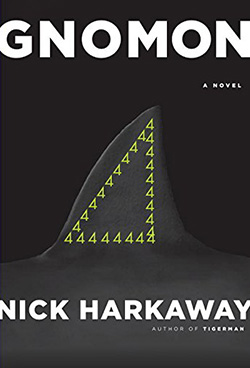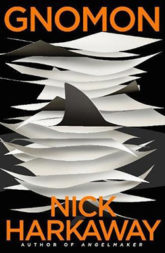It’s been nearly ten years since Nick Harkaway kung fu kicked his way into fiction with The Gone-Away World, a Douglas Adams-esque epic that announced the arrival of an author with an imagination to die for—and a sublimely sardonic sense of humour, too. There were of course those critics quick to dismiss him when he flexed some of the same muscles a second time in the underrated Angelmaker, but his next novel, 2014’s terrific yet tragic Tigerman, showed that Harkway had more to offer than madcap shenanigans punctuated by fits of wit.
Make that much more, if Gnomon is anything to go on: it’s easily his most ambitious book, and arguably his best yet. It’s certainly his biggest. Constructed like Cloud Atlas—and at least as long—its vast canvas takes in tales of inexplicable ancient history, our appallingly prescient present and, fittingly, the far flung future, all of which orbit Gnomon’s central Orwellian thread like spy satellites on an imminent collision course.
Towards the end of the 21st century, the institutions of law and order that hold sway in the world today have been rendered irrelevant by the System and the Witness:
The first is a government of the people, by the people, without intervention or representation beyond what is absolutely necessary: a democracy in the most literal sense, an ongoing plebiscite society. The second is the institution for which Britain perhaps above all other nations has always searched, the perfect police force. Over five hundred million cameras, microphones and other sensors taking information from everywhere, not one instant of it accessed initially by any human being. Instead, the impartial, self-teaching algorithms of the Witness review and classify it and do nothing unless public safety requires it.
Buy the Book


Gnomon
“In the gaps where the cameras cannot scan or where the human animal is yet too wild and strange, there are the Inspectors, prosecutorial ombudsmen to the surveillance state, reviewing and considering any case that passes a given threshold of intervention.” Gnomon, in simple terms, is the story of one such Inspector investigating one such case. It falls to Mielikki Neith, “an enthusiastic proponent of both the System and the Witness,” to delve into the life and times of one Diana Hunter, an indignant opponent of the institutions Neith holds so near and dear.
“The philosophical argument the System advances in its own favour—safety and empowerment in exchange for total personal transparency—did not persuade her. Quite apparently, she saw an irreducible virtue in the right to be unobserved.” Hunter’s was thus a home stripped of the technology the Witness watches with. Alas, that in itself attracted its attention. So intent was she on remaining off the radar that the Witness was caused to wonder—in an entirely detached fashion, naturally—what she had to hide. To wit, Hunter was taken in for interrogation. For mind-reading, really, the better to see if she was guilty of sedition.
But she died before any such determination could be made.
With no other evidence to assess whether or not her death was deliberate—whether it was murder or manslaughter or merely malfeasance—Neith uses the same thought-policing procedures to relive Hunter’s experiences. “Her record should be a ragged but truthful account of her self: less a cut-glass cross section than a jellied scoop lifted from a bowl.” In the hands of the right Inspector—and Neith, at least, believes herself to be “proper police”—that should be enough to bring the case to a close. To her surprise, however, she finds not facts, but a “farrago of lies.” Rather than a record of Hunter’s own story, other, seemingly disconnected stories come to the fore.
Kyriakos the banker is both blessed and cursed by the spectre of the shark that gobbled his watch; the embittered alchemist Athenais is called upon to solve an impossible murder that took place in a chamber no-one should know she created; the Ethiopian painter Berihun Bekele reinvents himself as the art director of a massively multiplayer role-playing game that may or may not contain be the basis of the system that became the Witness; and in a star-faring future society that “to your tiny, bounded and distressingly localised self” is likely to look like a fantasy, an “aspiring serial murderer of cosmoses” plots the end of everything.
 Harkaway delivers these “fleshed, persuasive histories” as novella-length digressions, interrupted on occasion ostensibly so that Neith can come up for air—and if I’m to find a fault in Gnomon, it’s that these sections frequently feel like cheat sheets. There’s something ingenious going on here, you see. Diverse as they are, the stories hidden in Hunter’s head “are not entirely disconnected. In each of them, a malign divinity touches the real, and threatens to tear the world apart.” Several other connections come to the fore in due course, not least the name of the novel, which also happens to be the nom-de-plume of the aforementioned cosmos-killer, and the designation given to the case Neith investigates, and… well. Let’s just say “it’s turtles all the way down, and the bottom turtle rests on the back of the top one.”
Harkaway delivers these “fleshed, persuasive histories” as novella-length digressions, interrupted on occasion ostensibly so that Neith can come up for air—and if I’m to find a fault in Gnomon, it’s that these sections frequently feel like cheat sheets. There’s something ingenious going on here, you see. Diverse as they are, the stories hidden in Hunter’s head “are not entirely disconnected. In each of them, a malign divinity touches the real, and threatens to tear the world apart.” Several other connections come to the fore in due course, not least the name of the novel, which also happens to be the nom-de-plume of the aforementioned cosmos-killer, and the designation given to the case Neith investigates, and… well. Let’s just say “it’s turtles all the way down, and the bottom turtle rests on the back of the top one.”
Initially, it appears that these “puzzles, philosophical loops and psychological paradoxes” have been designed to deny the Witness and its appointed Inspectors access to Hunter’s innermost thoughts and feelings by way of neural examination, but they’re more than an extension of her documented disdain for surveillance. It may even be that “Hunter’s narratives are not after all merely camouflage, but the whole point, the message as much as the medium.”
As such, the secondary texts that make Gnomon such a monolithic novel are of critical import to the enraptured reader, and picking out the pivotal parts—particularly the recurring themes and memes—is a puzzle that proves a pleasure to pursue. Too often, however, Harkaway’s hints rob us of our reward for recognising “a rare and beautiful mathematical caprice called a Markov chain: an apparently meaningful sequence in a flow of random numbers.” They make Gnomon a mite more accessible, yes, but it is not otherwise an easy read, so when answers are handed to us on pretty little platters, it cheapens an experience so rich as to be remarkable in every remaining respect.
In its cautionary characters and in its careful construction, in its incredible creativity and in its conversely very credible commentary, Harkaway’s latest is likely his greatest. As in The Gone-Away World and Angelmaker before it, the macro is simply magnificent—Gnomon bursts at the seams with appealing ideas, powerfully put, and perhaps more relevant than ever—but bolstered as it is by the micro that made Tigerman so moving at the same time as being buttressed by the author’s inquiries into the meaning of life in the digital era in The Blind Giant, this isn’t just a big, brash book about technology or horology, it’s a breathtakingly bold, barely-tamed beast of a read about being human in an increasingly alien age.
Gnomon is available from Knopf in the US and from William Heinemann in the UK.
Niall Alexander is an extra-curricular English teacher who reads and writes about all things weird and wonderful for The Speculative Scotsman, Strange Horizons, and Tor.com. He lives with about a bazillion books, his better half and a certain sleekit wee beastie in the central belt of bonnie Scotland.










